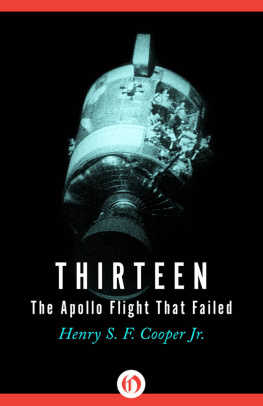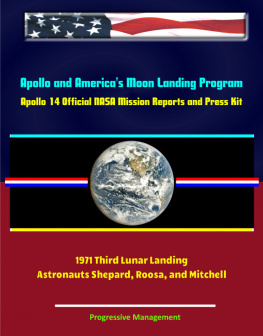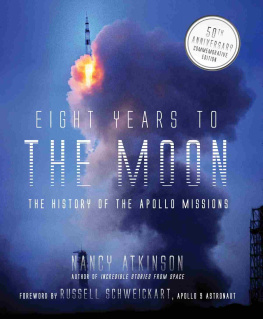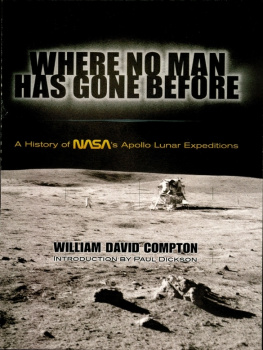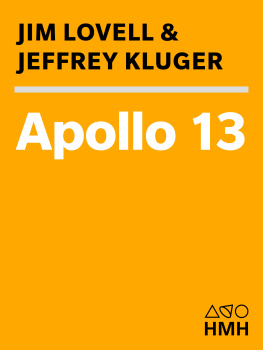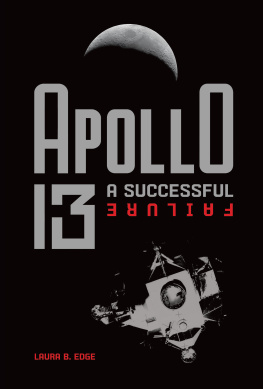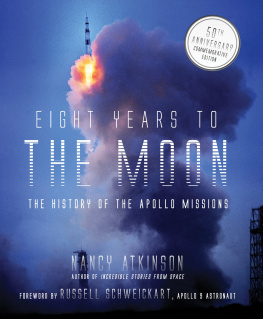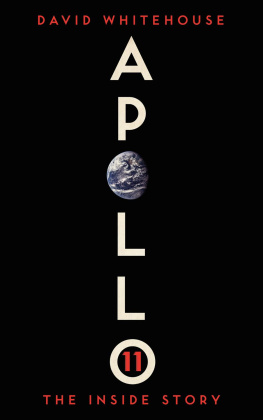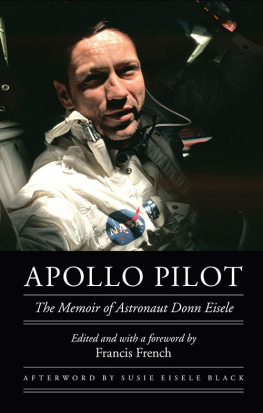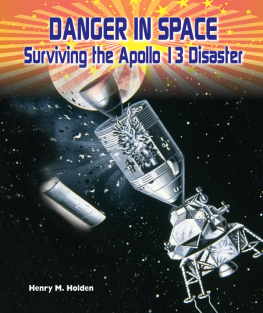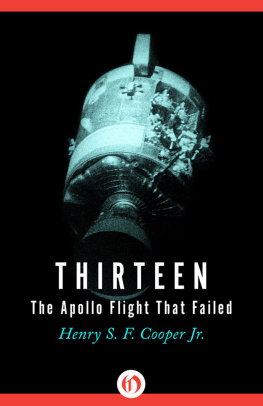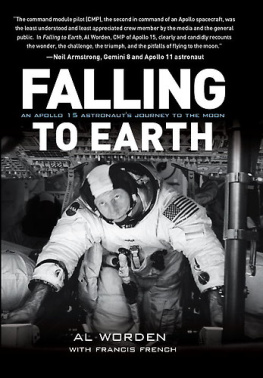Thirteen
The Apollo Flight That Failed
Henry S. F. Cooper Jr.

TO THE EDITORS AND STAFF OF THE NEW YORKER
Contents
OUT
AT A LITTLE AFTER nine central standard time on the night of Monday, April 13, 1970, there was, high in the western sky, a tiny flare of light that in some respects resembled a star exploding far away in our galaxy. At the Manned Spacecraft Center, near Houston, Texas, the glow was seen by several engineers who were using a rooftop observatory to track the Apollo 13 spacecraft, which had been launched two days before and was now a day away from the moon and two days from a scheduled moon landing. One of the group, Andy Saulietis, had rigged a telescope to a television set in such a way that objects in the telescopes field of view appeared on the screen. Above, the sky was clear and black, like deep water, with occasional clouds making ripples across it. Saulietis and his companionswho, incidentally, had no operational connection with the Apollo 13 mission but were following it for a related projecthad lost sight of the spacecraft, two hundred and five thousand miles away. However, they had been watching the much larger booster rocket that had propelled the spacecraft out of earth orbit and was trailing it to the moon; the booster had appeared as a pinprick of light that pulsed slowly, like a variable star, for it tumbled end over end as the result of dumping its fuel, and the sunlight glinted off it with varying intensity. Shortly before nine, the observers on the rooftop at Houston had lost track of the booster, too, for the pinprick had been almost at the limit of the resolving power of their equipment. Suddenly, near the middle of the TV screen, a bright spot appeared, and over the next ten minutes it grew to be a white disc the size of a dime. The rooftop watchers had no communications link with the Mission Control Center, about two hundred yards awaya large building consisting of two linked wings, with operations rooms in one, offices in the otherand they had no reason to connect the flaring light with the spacecraft or to be concerned with the safety of its crew: Captain James A. Lovell, Jr., of the United States Navy, who was in command; and the pilots for the command and lunar modules, John L. Swigert, Jr., and Fred W. Haise, Jr., both civilians. It was to be some time before either Mission Control or the astronauts themselves realized that one of the ships two oxygen tanks had burst, spewing into space three hundred pounds of liquid oxygen, which meant the loss of half the crafts supply of this element for generating electricity and water. The oxygen came out in one big blob, and in gravityless space it formed a gaseous sphere that expanded rapidly; the sunlight made it glow. In ten minutes, it was thirty miles in diameter. Then the white disc slowly disappearedthough traces of it were observed an hour later through a more powerful telescope in Canada.
Saulietis and the others assumed the white spot to be a defect in their television set, which had been flickering and blipping badly, so they went home to bed and thought nothing about the incident until the next morning. They were not the only ones who failed to grasp the situation. After two successful lunar landings, which had been preceded by two Apollo flights around the moon, no one at the Space Center was thinking in terms of accidents. Later, some of the first interpretations of what had happened would center on the notion that the spacecraft had been struck by a meteora borrowing from science fiction, for Jules Vernes space capsule in From the Earth to the Moon had almost been hit by one while it was approaching the moon. No one believed that there could be any flaw in the craft itself. Yet in the Mission Control Center, where dozens of automatic pens were scribbling data radioed from Apollo 13, at the time of the explosion the pens stopped writing for almost two secondsa drop-out of data indicating a major problem with either the electrical system or the system of transmitting data from the craft. No one noticed.
Inside the Mission Control Centers Operations Wing, a chunky, monolithic three-story structure as white and silent as a block of icethe geometric representation of an intelligence brooding on far-off spacethe flight controllers were at least as thoroughly cut off from the world around them as sailors belowdecks on a ship at sea. There were no windows, as there are none on the lower decks of a shipand, in a sense, the Operations Wing really was the lower decks of a ship, the upper deck being a couple of hundred thousand miles away in space. Astronauts are more like officers aboard a large ship than like solitary heroes, and that may account for some of the difficulty many people have in comprehending their roles. In the spacecraft and the Mission Control Center combined, there were about as many astronauts and flight controllers as there are officers aboard a big vessel, and they worked together as closely as officers belowdecks work with officers on the bridge. In fact, one of the controllers, the Flight Director, in some respects might have been regarded as the real skipper of the spacecraft, for although the relationship between the astronauts and the ground crew was a delicate, interdependent one, the astronauts usually did what he advised, particularly in an emergency. Though the flight controllers were on earth, they had, by means of telemetrydata radioed constantly from the spacecraftmore information about what was happening aboard than the astronauts themselves had. The walls of the Mission Operations Control Room, on the third floor of the Operations Wing, were the same color as the inside of the command modulegray. Five big screens at the front of the room might have been windows looking out into space: the middle screen showed the earth on the left and the moon on the right, with a bright-yellow line representing the spacecrafts trajectory as it lengthened slowly between them. And some of the consoles at which the flight controllers sat duplicated equipment aboard the spacecraft.
The flight controllers, most of whom were in their twenties and thirties, sat in four rows. Before the accident, they were relaxedeven bored. The first fifty-five hours of the flight had gone so smoothly that they had once sent word to the astronauts that they were putting us to sleep down here. One team of flight controllers had been reduced to commenting on the number of thirteens that cropped up; for example, the time of launch in Houstonthe official time for the flighthad been 13:13, or in our terms 1:13 P.M. About the only event requiring the controllers close attention since Apollo 13 left earth orbit had been a small rocket burn the day before, called a hybrid transfer maneuver, which had aimed the spacecraft for its target on the moon, the Fra Mauro hillsand, incidentally, had taken it off a free-return trajectory, the safe path most previous Apollos had followed so that in the event of trouble the spacecraft could, without navigational adjustment, swing around the moon and head back to earth. Now, a couple of minutes before nine, one of the flight controllers, the Retrofire Officer, whose responsibility it was always to have a plan ready, in case of trouble, for bringing the astronauts home, sent word to the Flight Director that another bridge was about to be burned: via a pneumatic-tube system connecting the consoles, he dispatched a routine memorandum to the effect that the spacecraft was nearing the spot where it could no longer reverse its direction and return directly to earth if anything went wrong.
There were a couple of dozen controllers on duty, of whom only about half were directly involved with the running of the spacecraft at any given time. In the front row, which was called the Trench, sat three Flight Dynamics Engineers, the men responsible for the ships trajectory: from right to left, the Guidance Officer, or GUIDO, who was the chief navigation officer; the Flight Dynamics Officer, or FIDO, who plotted the trajectory and made sure the spacecraft followed it; and the Retrofire Officer, or RETRO, who was in charge of the spacecrafts rentry into the earths atmosphere. Most of the second row, behind the Trench, was taken up by the Systems Operations Engineers, who monitored the equipment inside the spacecraft: in the center, the EECOM, who looked after the electrical, environmental, and other systems in the command module, where the astronauts rode; next to him, the LM Systems Officer, or TELMU, who did the same thing for the lunar module, in which the astronauts would land on the moon; and then two Guidance and Navigation Control Officersone, the GNC, for the command module, and the other, the CONTROL, for the lunar modulewho were in charge not only of the guidance and navigation equipment in the two modules but of the propulsion systems as well. To their left was the Spacecraft Communicator, knownfrom the old Mercury-capsule daysas the CAPCOM, the only man who could talk directly with the astronauts, and to his left was the Flight Surgeon. Behind the Flight Surgeon, in the third row, was the Instrument and Communications Officer, or INCO, who was responsible for the radios and telemetry transmitters aboard the spacecraft. Finally, in the center of the third rowa good vantage point for keeping an eye on everyone elsethere was the Flight Director, the ships earthbound co-captain. (In the fourth row sat administrators, including a Public Affairs Officer.)

